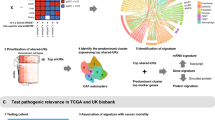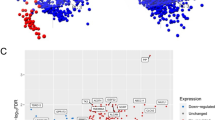Abstract
To perform bioinformatics analysis on the papillary thyroid carcinoma (PTC) gene chip dataset to explore new biological markers for PTC. The gene expression profiles of GSE3467 and GSE6004 chip data were collected by GEO2R, and the differentially expressed genes (DEGs) were selected for Gene Ontology (GO) and Kyoto Encyclopedia of Genes and Genomes (KEGG) enrichment analyses. Protein–protein interaction (PPI) relationship analysis was achieved using STRING, and the hub genes were obtained using the Cytoscape software. GEPIA was used to validate the expressions of the hub genes in the normal and tumor tissues and to conduct survival analyses. Pertinent genetic pathology results were fetched using the HPA database. Finally, the key genes were clinically verified by reverse transcription-polymerase chain reaction. 97 genes were jointly up-regulated and 107 genes were jointly down-regulated in GSE3467 and GSE6004. GO function enrichment analysis revealed that the DEGs were involved in the regulation of calcium ion transport into cytosol, integrin binding, and cell adhesion molecule binding. KEGG pathway enrichment analysis indicated that the DEGs were chiefly associated with thyroid cancer and non-small cell lung cancer. According to the PPI network, 30 key target genes were identified. Only the expressions of ANK2, TLE1, and TCF4 matched between the normal and tumor tissues, and were associated with disease prognosis. When compared with the normal thyroid tissues, the protein and mRNA expressions of ANK2, TLE1, and TCF4 were down-regulated in PTC. Significant differences exist in overall gene expression between the thyroid tissues of patients with PTC and those of healthy people. Furthermore, the differential genes ANK2, TLE1, and TCF4 are expected to be reliable molecular markers for the mechanism study and diagnosis of PTC.









Similar content being viewed by others
Data availability
All data generated or analyzed during this study are included in this published article.
References
Deng Y, Li H, Wang M et al (2020) Global burden of thyroid cancer from 1990 to 2017. JAMA Netw Open 3(6):e208759
Siegel RL, Miller KD, Fuchs HE et al (2021) Cancer statistics. CA Cancer J Clin 71(1):7–33
Liu Z, Jiang Y, Fang Q et al (2019) Future of cancer incidence in Shanghai, China: predicting the burden upon the ageing population. Cancer Epidemiol 60:8–15
Wan Y, Zhang X, Leng H et al (2020) Identifying hub genes of papillary thyroid carcinoma in the TCGA and GEO database using bioinformatics analysis. PeerJ 8:e9120
Vasileiadis I, Boutzios G, Karalaki M et al (2018) Papillary thyroid carcinoma of the isthmus: total thyroidectomy or isthmusectomy? Am J Surg 216(1):135–139
Ywata de Carvalho A, Kohler HF, Gomes CC et al (2022) Predictive factors for recurrence of papillary thyroid carcinoma: analysis of 4085 patients. Acta Otorhinolaryngol Ital 41(3):236–242
Jiang HJ, Hsiao PJ (2020) Clinical application of the ultrasound-guided fine needle aspiration for thyroglobulin measurement to diagnose lymph node metastasis from differentiated thyroid carcinoma-literature review. Kaohsiung J Med Sci 36(4):236–243
Liang B, Li C, Zhao J (2016) Identification of key pathways and genes in colorectal cancer using bioinformatics analysis. Med Oncol 33(10):111
You X, Zhang Y, Long Q et al (2020) Does single gene expression omnibus data mining analysis apply for only tumors and not mental illness? A preliminary study on bipolar disorder based on bioinformatics methodology. Medicine 99(35):e21989
Jiang P, Liu XS (2015) Big data mining yields novel insights on cancer. Nat Genet 47(2):103–104
Lu X, Zhang X (2006) The effect of GeneChip gene definitions on the microarray study of cancers. Bioessays 28(7):739–746
Casadio R, Martelli PL, Savojardo C (2022) Machine learning solutions for predicting protein–protein interactions. WIREs Comput Mol Sci. https://doi.org/10.1002/wcms.1618
Shen Y, Dong S, Liu J et al (2020) Identification of potential biomarkers for thyroid cancer using bioinformatics strategy: a study based on GEO Datasets. Biomed Res Int 2020:9710421
Wang S, Wu J, Guo C et al (2020) Identification and validation of novel genes in anaplastic thyroid carcinoma via bioinformatics analysis. Cancer Manag Res 12:9787–9799
Tang Z, Li C, Kang B et al (2017) GEPIA: a web server for cancer and normal gene expression profiling and interactive analyses. Nucleic Acids Res 45(W1):W98–W102
Wang Y, Zhou Z, Chen L et al (2021) Identification of key genes and biological pathways in lung adenocarcinoma via bioinformatics analysis. Mol Cell Biochem 476(2):931–939
Thul PJ, Lindskog C (2018) The human protein atlas: a spatial map of the human proteome. Protein Sci 27(1):233–244
Bray F, Ferlay J, Soerjomataram I et al (2018) Global cancer statistics 2018: GLOBOCAN estimates of incidence and mortality worldwide for 36 cancers in 185 countries. CA Cancer J Clin 68(6):394–424
Nan BY, Xiong GF, Zhao ZR et al (2021) Comprehensive identification of potential crucial genes and miRNA-mRNA regulatory networks in papillary thyroid cancer. Biomed Res Int 2021:6752141
Yu J, Deng Y, Liu T et al (2020) Lymph node metastasis prediction of papillary thyroid carcinoma based on transfer learning radiomics. Nat Commun 11(1):4807
Stein R, Harmon TS, Harmon CE et al (2021) Pancreatic metastasis from papillary thyroid carcinoma: case report and literature review. Hell J Nucl Med 24(2):140–148
Zhao H, Wu L, Yan G et al (2021) Inflammation and tumor progression: signaling pathways and targeted intervention. Signal Transduct Target Ther 6(1):263
Ye R, Liu D, Guan H et al (2021) AHNAK2 promotes thyroid carcinoma progression by activating the NF-kappaB pathway. Life Sci 286:120032
Gao X, Chen Y, Chen M et al (2018) Identification of key candidate genes and biological pathways in bladder cancer. PeerJ 6:e6036
Sharma N, Bham K, Senapati S (2020) Human ankyrins and their contribution to disease biology: an update. J Biosci 45:146
Cao W, Wei W, Zhan Z et al (2018) Regulation of drug resistance and metastasis of gastric cancer cells via the microRNA647-ANK2 axis. Int J Mol Med 41(4):1958–1966
Chen Y, Löhr M, Jesnowski R (2010) Inhibition of ankyrin-B expression reduces growth and invasion of human pancreatic ductal adenocarcinoma. Pancreatology 10(5):586–596
Schabort JJ, Nam AR, Lee KH et al (2020) ANK2 hypermethylation in canine mammary tumors and human breast cancer. Int J Mol Sci 21(22):8697
Liao C, Huang X, Gong Y et al (2019) Discovery of core genes in colorectal cancer by weighted gene co-expression network analysis. Oncol Lett 18(3):3137–3149
Zhuang L, Ding W, Ding W et al (2021) lncRNA ZNF667-AS1 (NR_036521.1) inhibits the progression of colorectal cancer via regulating ANK2/JAK2 expression. J Cell Physiol 236(3):2178–2193
Stein L, Rothschild J, Luce J et al (2010) Copy number and gene expression alterations in radiation-induced papillary thyroid carcinoma from chernobyl pediatric patients. Thyroid 20(5):475–487
Pinto K, Chetty R (2021) Gene of the month: TLE 1. J Clin Pathol 74(3):137–140
Wang Y, Yuan D, Zhou L et al (2020) Transducin-Like enhancer of split-1 inhibits malignant behaviors in vitro and predicts a better prognosis in pancreatic ductal adenocarcinoma. Front Oncol 10:576
Ma Q, Xiao F, Hao Y et al (2021) The prognostic role of the transducin-like enhancer of split protein family in lung adenocarcinoma. Transl Lung Cancer Res 10(7):3251–3263
Sivakoti S, Uppin SG, Uppin MS et al (2021) Tissue microarray based immunohistochemical study of TLE1 in synovial sarcoma and its histologic mimics. Indian J Pathol Microbiol 64(2):310–315
Bozdogan N, Dilek GB, Benzer E et al (2017) Transducing-Like enhancer of split 1: a potential immunohistochemical marker for glomus tumor. Am J Dermatopathol 39(7):524–527
Li C, Zhu B, Chen J et al (2015) Novel prognostic genes of diffuse large B-cell lymphoma revealed by survival analysis of gene expression data. Onco Targets Ther 8:3407–3413
Teixeira JR, Szeto RA, Carvalho VMA et al (2021) Transcription factor 4 and its association with psychiatric disorders. Transl Psychiatry 11(1):19
Chen HY, Bohlen JF, Maher BJ (2021) Molecular and cellular function of transcription factor 4 in pitt-hopkins syndrome. Dev Neurosci 43(3–4):159–167
in‘tHout FE, van der Reijden BA, Monteferrario D et al (2014) High expression of transcription factor 4 (TCF4) is an independent adverse prognostic factor in acute myeloid leukemia that could guide treatment decisions. Haematologica 99(12):e257–e259
Liu L, Zeng Z, Yi J et al (2019) Expression and clinical significance of transcription factor 4 (TCF4) in epithelial ovarian cancer. Cancer Biomark 24(2):213–221
Sun S, Yang X, Qin X et al (2020) TCF4 promotes colorectal cancer drug resistance and stemness via regulating ZEB1/ZEB2 expression. Protoplasma 257(3):921–930
Lee JH, Son MW, Kim KJ et al (2016) Prognostic and clinicopathological significance of transducer-like enhancer of split 1 expression in gastric cancer. J Gastric Cancer 16(1):21–27
Xu Y, Zhao J, Dai X et al (2019) High expression of CDH3 predicts a good prognosis for colon adenocarcinoma patients. Exp Ther Med 18(1):841–847
Acknowledgements
This work was supported by the Hubei Natural Science Foundation of China under Grant No.2016CFB673. MJEditor (www.mjeditor.com) for its linguistic assistance during the preparation of this manuscript.
Funding
This study was funded by the Hubei Natural Science Foundation of China Grant No. 2016CFB673.
Author information
Authors and Affiliations
Contributions
ML reviewed literature, designed and performed the experiments. ML, ZW, JY and HX collected the samples and analyzed the data. ML drafted the manuscript. ML, HY and BQ contributed to the discussion and reviewed the manuscript. All authors agreed to submit to the current journal; gave final approval of the version to be published; and agree to be accountable for all aspects of the work.
Corresponding authors
Ethics declarations
Conflict of interest
The authors declare that they have no conflicts of interests.
Additional information
Publisher's Note
Springer Nature remains neutral with regard to jurisdictional claims in published maps and institutional affiliations.
Rights and permissions
Springer Nature or its licensor (e.g. a society or other partner) holds exclusive rights to this article under a publishing agreement with the author(s) or other rightsholder(s); author self-archiving of the accepted manuscript version of this article is solely governed by the terms of such publishing agreement and applicable law.
About this article
Cite this article
Liao, M., Wang, Z., Yao, J. et al. Identification of potential biomarkers for papillary thyroid carcinoma by comprehensive bioinformatics analysis. Mol Cell Biochem 478, 2111–2123 (2023). https://doi.org/10.1007/s11010-022-04606-x
Received:
Accepted:
Published:
Issue Date:
DOI: https://doi.org/10.1007/s11010-022-04606-x




